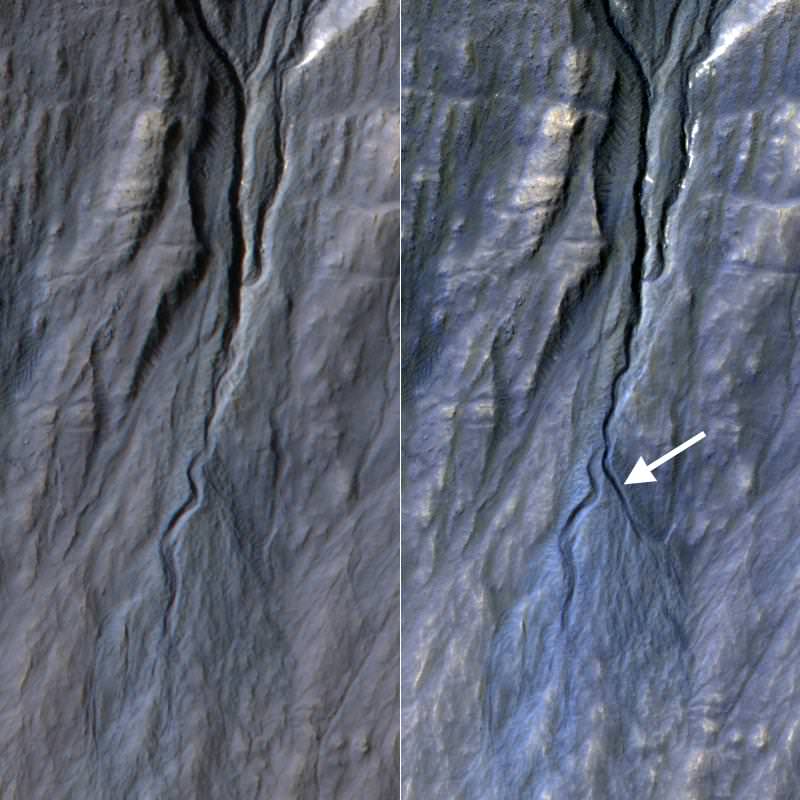Check out the groove! In the blink of a geological lifetime, a new gully has appeared on the planet Mars. These images from NASA’s Mars Reconnaissance Orbiter show a new channel in the southern hemisphere region of Terra Siernum that appeared between November 2010 and May 2013.
While there’s a lot of chatter about water on Mars, this particular feature is likely not due to that liquid, the agency added.
“Gully or ravine landforms are common on Mars, particularly in the southern highlands. This pair of images shows that material flowing down from an alcove at the head of a gully broke out of an older route and eroded a new channel,” NASA stated.
It’s unclear in what season the activity occurred because the observations took place more than a Martian year apart, NASA added. These ravines tend to happen in the southern highlands and other mid-latitude regions on Mars.
“Before-and-after HiRISE pairs of similar activity at other sites demonstrate that this type of activity generally occurs in winter, at temperatures so cold that carbon dioxide, rather than water, is likely to play the key role,” the agency said.
Last week, the agency also announced that MRO recovered from an unplanned computer swap that put the spacecraft into safe mode. Incidents of this nature have happened four times before, the agency noted.
Source: NASA


Carbon Dioxide? Wow. Correct me if I’m wrong but CO2 cannot exist as a liquid under Mars’ atmospheric pressure (or Earth’s for that matter), so it goes straight from gas to solid as it cools. Was this an avalanche of CO2 frost?
It appears to me that there is a sub-surface rift apparent beneath and that the surface layers collapsed, as well as a flow of some type of liquid.
As Jim E pointed out, CO2 doesn’t exist as a liquid – it goes straight from dry ice and sublimates to gas… If one looks at the feature one can clearly see the most likely candidate is water – The gully snakes – which is known as meandering.
Meandering is unique to water flowing and changing course – common hydrodynamics 101. Taught in every college hydrology/geology class when studying and modeling rivers, streams and channels.
I have never in my life seen anything frozen have the erosive capability that water has to cut meandering channels… Sure, glacers and ice can move boulders and rocks but ice and frozen substance does not tend to cut compact channels like these (it takes glaciers thousands of years on earth the cut anything resembling a channel – and they certainly don’t curve or meander).
“…This pair of images shows that material flowing down from an alcove…”
The absurdity of this assertion speaks for itself… ‘material’ generally isn’t ‘flowing’…
I am surprised NASA would suggest CO2 when clearly H2O is the most likely candidate.. Perhaps their geology staff were unavailable to analyze this image..
Weeasle
I don’t understand the confusion above. Carbon Dioxide expands almost explosively as it passes from solid form into gas. CO2 ice crystals mixed in Martian soils/dust and undergoing state change, will obviously lubricate those soils, causing them to become unstable _especially_ on steep slopes or cliff faces. When CO2 either freezes or sublimates it could definitely create soils displacement and motion and cause landslides… this is a ‘no brainer’.
What get me is how Martian dust and soils can at times assume liquid like properties when held in suspension… either by gas expansion/contractions or by lofting during storms. Got sand dunes?
Such as: How can CO2 ice at 1/3 earths gravity sublimating cause soil/sand/gravel to erode sharply curving and narrow, deep channels?
Oops, My reply was supposed to be to Subspace.
To Aqua4U – I agree landslides due to frozen material sublimating is a possibility, however, on earth landslides almost never result in curved river/stream bed-like features within valleys/ravines as apparent in the above photo. I doubt 300% less gravity would change this fundamental.
Particularly, note the alluvial delta feature at the bottom of these stream-bed like features. Again, if it quacks like a duck…
Also another fundamental wouldn’t likely change at 300% less gravity: Lubrication generally needs a lubricant which is a viscous liquid. I have never seen a sold or semi-solid act in this capacity…
I would have appreciated some explanation by the Nasa official of the purposed mechanism to explain the features above other than just … ‘CO2 is playing the key role here.’ As it stands I don’t accept the claims that water was not involved.
I recall reading on this site an article mentioning MRO witnessed avalanches in a crater on Mars in which water and CO2 ice melting rapidly were responsible. The article mentioned that water was usually associated with the CO2 ices and necessary to trigger the landslides…
FYI,
This quandary perplexed me so that I researched..
This article goes some way towards a hypothesis on the proposed mechanism (but still falls far short of explaining the features of the photo above – in particular the alluvium):
http://www.universetoday.com/75786/more-recent-landslides-spotted-on-mars/
These articles offer direct contradiction (and one is even straight from NASA):
http://au.news.yahoo.com/world/a/21421190/nasa-says-it-may-have-discovered-flowing-water-on-mars/
http://www.britannica.com/EBchecked/media/124492/A-patch-of-water-ice-sheltered-on-the-floor-of
I really think that is non sence.How can you say something is common unless you visit there in person.That like me telling you what is common and not common about Germany without going there…Don’t be sheep ask q…
Mental illness is not uncommon. I can say that without going there personally.
German is commonly spoken in Germany. I can say that without going there personally.